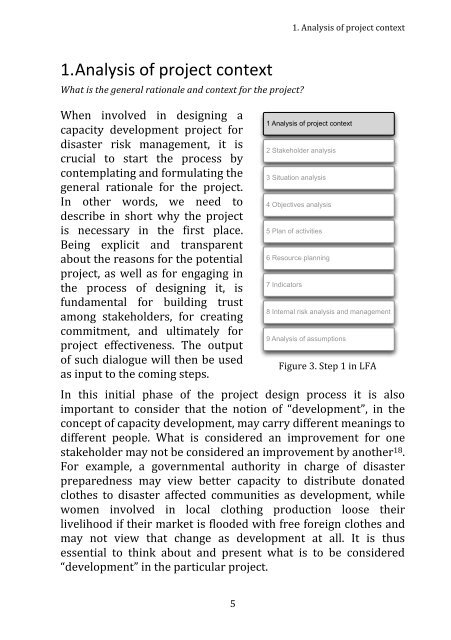Designing Capacity Development for Disaster Risk Management : A ...
Designing Capacity Development for Disaster Risk Management : A ...
Designing Capacity Development for Disaster Risk Management : A ...
Create successful ePaper yourself
Turn your PDF publications into a flip-book with our unique Google optimized e-Paper software.
1. Analysis of project context<br />
1. Analysis of project context <br />
What is the general rationale and context <strong>for</strong> the project? <br />
When involved in designing a <br />
capacity development project <strong>for</strong> <br />
disaster risk management, it is <br />
crucial to start the process by <br />
contemplating and <strong>for</strong>mulating the <br />
general rationale <strong>for</strong> the project. <br />
In other words, we need to <br />
describe in short why the project <br />
is necessary in the first place. <br />
Being explicit and transparent <br />
about the reasons <strong>for</strong> the potential <br />
project, as well as <strong>for</strong> engaging in <br />
the process of designing it, is <br />
fundamental <strong>for</strong> building trust <br />
among stakeholders, <strong>for</strong> creating <br />
commitment, and ultimately <strong>for</strong> <br />
project effectiveness. The output <br />
of such dialogue will then be used <br />
as input to the coming steps. <br />
1 Analysis of project context<br />
2 Stakeholder analysis<br />
3 Situation analysis<br />
4 Objectives analysis<br />
5 Plan of activities<br />
6 Resource planning<br />
7 Indicators<br />
8 Internal risk analysis and management<br />
9 Analysis of assumptions<br />
Figure 3. Step 1 in LFA <br />
In this initial phase of the project design process it is also <br />
important to consider that the notion of “development”, in the <br />
concept of capacity development, may carry different meanings to <br />
different people. What is considered an improvement <strong>for</strong> one <br />
stakeholder may not be considered an improvement by another 18 . <br />
For example, a governmental authority in charge of disaster <br />
preparedness may view better capacity to distribute donated <br />
clothes to disaster affected communities as development, while <br />
women involved in local clothing production loose their <br />
livelihood if their market is flooded with free <strong>for</strong>eign clothes and <br />
may not view that change as development at all. It is thus <br />
essential to think about and present what is to be considered <br />
“development” in the particular project. <br />
5
















